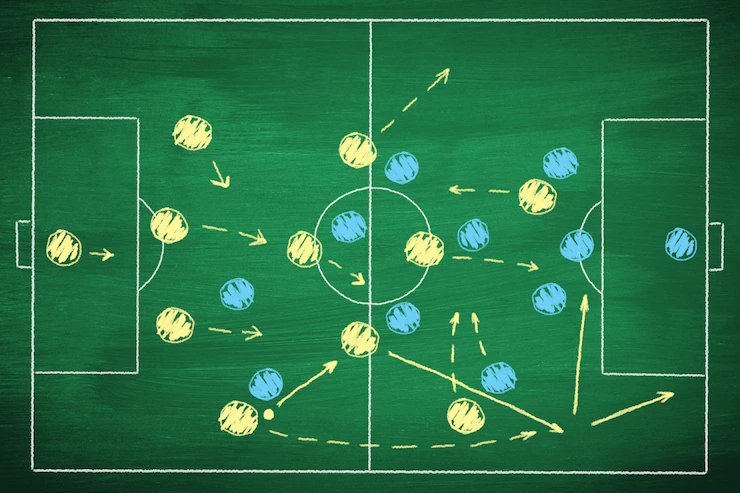
Decoding the Game: A Comprehensive Guide to Football Tactical Analysis
Football, the beautiful game, is a captivating spectacle of athleticism, skill, and strategy. Beyond the dazzling goals and breathtaking saves lies a complex tapestry of tactical decisions that dictate the flow and outcome of a match. Understanding these tactics is key to truly appreciating the sport and, for coaches and aspiring analysts, crucial for success. This article delves into the intricacies of football tactical analysis, providing a comprehensive guide for beginners and seasoned observers alike.
I. Setting the Stage: Pre-Match Preparation and Data Gathering
Effective tactical analysis doesn’t begin on matchday. Thorough preparation is paramount. Before even considering formations or player movements, you need a solid foundation of information:
-
Opponent Scouting: This is the cornerstone of pre-match analysis. Study your opponent’s recent matches, focusing on:
- Formation and System: Identify their preferred formation and how it adapts throughout games. Do they utilize a high press, a deep block, or something in between?
- Key Players: Pinpoint their star players and understand their strengths, weaknesses, and typical positions. Analyze their passing patterns, shooting accuracy, and defensive contributions.
- Set-Piece Strategies: Pay close attention to their set-piece routines – both attacking and defending. Identify patterns and potential vulnerabilities.
- Weaknesses: Look for consistent weaknesses in their game, such as vulnerability to through balls, poor aerial defense, or slow transitions. Exploiting these weaknesses is crucial.
-
Team Scouting (Your Own Team): Equally important is a thorough understanding of your own team’s strengths and weaknesses. Analyze:
- Player Fitness and Form: Consider player fitness levels and recent performance. Injuries and suspensions can significantly impact tactical decisions.
- Team Strengths: Identify areas where your team excels, such as pace on the counter, set-piece prowess, or dominating midfield possession.
- Team Weaknesses: Understand areas needing improvement, such as defensive frailties or struggles in creating chances.
-
Data Acquisition: Modern football analysis relies heavily on data. Utilize resources such as:
- Match Statistics: Websites and apps provide detailed statistics on passing accuracy, shots on target, possession, tackles, and more.
- Video Analysis: Recording matches allows for detailed review of player movements, formations, and tactical adjustments. Software like Wyscout and InStat provide advanced tools for video analysis.
- Tracking Data: Sophisticated tracking systems provide granular data on player positioning, speed, and distance covered. This data offers a deeper understanding of tactical execution.
II. During the Match: Observing and Recording Key Tactical Elements
Matchday is where the theory meets practice. While enjoying the game, focus on observing and recording key elements:
- Formation and Structure: Note the initial formations of both teams and how they evolve throughout the match. Observe changes in shape, player positioning, and defensive lines.
- Passing Networks: Identify the main passing lanes and pathways used by each team. Analyze the frequency and accuracy of passes, highlighting key playmakers and their influence.
- Attacking and Defensive Strategies: Observe how each team builds up play, creates chances, and defends against attacks. Note the use of different tactical approaches, such as counter-attacks, positional play, or pressing strategies.
- Player Roles and Responsibilities: Pay attention to the individual roles and responsibilities of key players. Identify players who are actively involved in both offensive and defensive phases of the game.
- Transitions: Analyze how both teams transition from attack to defense and vice-versa. Identify weaknesses and strengths in these crucial phases of the game.
- Set Pieces: Observe the execution of set pieces, noting the positioning of players and the effectiveness of the strategies employed.
III. Post-Match Analysis: Deeper Dive and Identifying Key Insights
After the match, the real work begins. This is where you synthesize your observations and data to gain deeper insights:
- Quantitative Analysis: Use statistical data to support your qualitative observations. Compare key metrics like possession, passing accuracy, and shots on target to identify areas of strength and weakness.
- Qualitative Analysis: Analyze the video footage to gain a more nuanced understanding of the tactical battles. Focus on specific moments and sequences of play to identify patterns and key decisions.
- Identifying Key Tactical Battles: Pinpoint the areas on the field where the most significant tactical battles took place. Analyze how these battles influenced the outcome of the match.
- Analyzing Tactical Adjustments: Assess the tactical adjustments made by both managers during the match. Evaluate the effectiveness of these adjustments and their impact on the game.
- Drawing Conclusions and Recommendations: Based on your analysis, draw conclusions about the strengths and weaknesses of both teams. Develop recommendations for improvement, considering the specific context of the match.
IV. Tools and Techniques for Enhanced Analysis
Numerous tools and techniques can enhance your tactical analysis:
- Video Editing Software: Software like Adobe Premiere Pro or Final Cut Pro allows for detailed video editing and annotation.
- Tactical Analysis Software: Specialized software like Wyscout and InStat offers advanced features for tracking player movements, drawing diagrams, and analyzing statistics.
- Data Visualization: Use charts, graphs, and heatmaps to visualize data and identify patterns.
- Collaboration: Working with others can provide different perspectives and enhance the quality of your analysis.
V. Beyond the Basics: Advanced Concepts
For those seeking a deeper understanding, exploring these advanced concepts is beneficial:
- Space Exploitation: Analyzing how teams use and exploit space on the field is crucial. Identifying gaps and creating passing lanes are essential aspects of attacking play.
- Pressing Strategies: Different pressing systems have varying levels of intensity and effectiveness. Understanding the nuances of these strategies is crucial.
- Counter-Attacking Principles: Efficient counter-attacking requires speed, precision, and timing. Analyzing successful and unsuccessful counter-attacks provides valuable insights.
- Positional Play: This sophisticated approach focuses on controlled possession and creating superior positional advantages. Understanding its principles requires deep tactical knowledge.
VI. Conclusion: The Continuous Learning Journey
Football tactical analysis is an ongoing learning process. By consistently practicing these techniques, you can develop a deeper understanding of the game and enhance your ability to identify key tactical elements. Remember to stay updated on the latest tactical trends and continue to refine your analytical skills. The beauty of football lies not only in the spectacle but also in the intricate strategies that unfold on the pitch, waiting to be deciphered. By mastering the art of tactical analysis, you unlock a new level of appreciation for this captivating sport.



